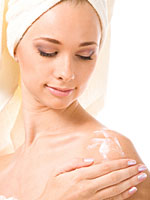Most women have spent years pampering their faces but forgetting to take care of some areas of their body. This Health.com article provides some tips on taking care of one's body from head to toe.
 |
| Image Source: health.com |
Wise to the sun’s evil ways, you diligently coat your face in sunscreen every day. Nice work. But as you slather on the sunscreen, you may notice that the skin on your hands doesn’t look quite as ageless as your complexion. “Your hands, along with your neck and chest, are what I call give-away areas,” says Kenneth Howe, MD, a dermatologist in Brooklyn, New York. “They can show your real age, even if you have a youthful-looking complexion.” That’s because these three areas get almost as much damaging sun exposure as your face—but they get a lot less care. Remedy the situation with these strategies that will keep you looking gorgeous from head to toe for years to come.
Take time off your...hands
“Most women notice the first signs of aging on their hands in their early 30s, as the skin begins to thin and lose moisture and sunspots come to the surface,” says Robin Ashinoff, MD, chief of dermatologic and Mohs surgery and cosmetic dermatology at Hackensack Medical Center in New Jersey. In your 40s or 50s, you may also notice a loss of fat, which makes tendons and veins more visible beneath skin. There are ways to remedy the problem, but the easiest fix is to prevent it from happening in the first place by applying a thick layer of moisturizing sunscreen (SPF 30 or higher) immediately after washing your hands.
Simple fixes: Improve the look of your skin by smoothing a retinol cream, like RoC Retinol Correxion Deep Wrinkle Serum, on the backs of your hands every night. Retinol “minimizes fine lines while stimulating cell renewal to even skin tone,” Dr. Howe says. For darker spots, ask your doctor about prescription Tri-Luma, a blend of the bleaching agent hydroquinone and the retinoid tretinoin; a 30-gram tube costs $188 and lasts about six months (apply at bedtime for several months).
Intensive solutions: If you still see discoloration, head to your derm for a series of one to three treatments with an Nd:YAG or Q-Switched Ruby laser ($300 to $500), which can erase spots. Injecting hands with a hyaluronic-acid filler like Restylane will restore lost fullness; one to two syringes (costing about $850 per syringe) are usually needed to treat both hands, and results last about six months. If your skin is thoroughly dappled and has a crepey texture, fractional lasers can “sweep the area clean while stimulating a good deal of collagen production, making skin look healthier,” Dr. Howe explains. Unfortunately, the treatments aren’t cheap—you may need up to five at a cost of $1,000 each.
Take time off your...chest
“I often see women in their early 20s who have blotchy, freckled chests—a clear sign that their skin has gotten too much sun,” Dr. Howe says. Eventually, the broken vessels and brown splotches will be joined by wrinkles, loose skin, and white spots, which appear when pigment-making cells sustain so much damage that they simply shut down.
Simple fixes: The best way to keep your decolletage from deteriorating? Cover it with clothing or sunscreen during the day and a lotion that contains antioxidants like co-enzyme Q10 and vitamin E at night; try Gold Bond Ultimate Restoring Skin Therapy Lotion. “The combination of these two ingredients neutralizes sun-induced free radicals and helps reduce wrinkles,” Dr. Ashinoff explains. To improve skin tone and texture, dermatologists often prescribe retinoid creams, like Renova and Avage. If the skin on your chest is too sensitive for these, over-the-counter retinol or retinaldehyde lotions work similarly but not as quickly; try Avène Eluage Cream ($39; www.spalook.com).
Intensive solutions: Glycolic peels ($300 to $500) can lighten spots and improve texture on large areas of skin. Fractional lasers also “do a good job of correcting most aspects of sun damage: freckling, blotchiness, rough texture, and deep lines,” Dr. Howe says. Each treatment costs a bundle (about $1,000), though, and you’ll need between three and six. If discoloration is your main concern, intense pulsed light can wipe out brown spots and red vessels in three to six treatments and is slightly less expensive ($500 to $900 per treatment).
Take time off your...neck
Smoking, genetics, sudden weight loss, the sun—you can blame any or all of these for the current state of your neck. Horizontal grooves and blotchy tone are a result of too much time in the sun without sunscreen. Far more troubling, however, is the dreaded “turkey neck” that may appear thanks to a combination of sagging skin and protruding neck bands (caused by the tightening of a thin sheet of muscle called the platysma).
Simple fixes: Since the skin on your neck is thin and sensitive, all-star ingredients like retinoids and alpha hydroxy acid may be too irritating. Instead, doctors suggest applying face creams that have gentle anti-agers like copper peptides, which boost collagen production and tighten skin over time; find them in Dr. Jeannette Graf, MD, Copper Collagen Infusion.
Intensive solutions: Unfortunately, creams are no match for ultra-lax skin and rigid bands. Botox ($500 to $1,000 a visit) is the best solution because it weakens the platysma muscle, relaxing the tight cords so skin lies flat for up to six months. The radio frequency treatment Thermage can tighten the neck in just one visit, but it’s really pricey, costing upwards of $5,000. It’s a relatively new treatment, so doctors aren’t sure how long results will last. But the company that developed the technology estimates at least several years.
Get more updates on beauty and health through this Lift and Glow Pro Facebook page.
